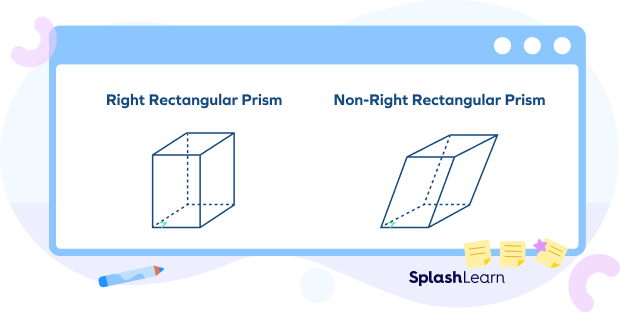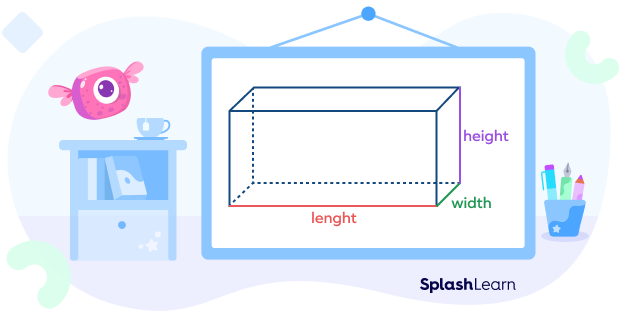What Is a Right Rectangular Prism?
In geometry, a rectangular prism can be defined as a 3-dimensional solid shape that has 6 faces with its base as rectangles. Rectangular prisms can be of two types, namely right rectangular prisms and non-right (oblique) rectangular prisms.

The right rectangular prism has two parallel end faces and four lateral faces, each one of which is a rectangle; the faces are perpendicular to each of its bases. The faces of a non-right rectangular prism (oblique prism) are parallelograms.
A right rectangular prism is also called a cuboid.

We can find the shape of a right rectangular prism all around us—in a truck, a chest of drawers, and an aquarium.

Recommended Games
Properties of a Right Rectangular Prism:
- It has 8 vertices, 12 sides, and 6 rectangular faces.
- All its opposite faces are congruent.
- The angle between its base and sides is 90 degrees or right angle.
- All its faces are rectangles and parallel.
Surface Area and Volume of a Right Rectangular Prism
Let’s consider this right rectangular prism with the marked length, width, and height.

Since all its faces are rectangles and opposite faces are equal, the surface area of a right rectangular prism can be calculated using the following formula:
| Lateral Surface Area = 2 × height (length + width) Total Surface Area = 2 {( width × length )+( length × height ) + (width × height )} |
Volume of a right rectangular prism is obtained by multiplying all three dimensions—length, height, and width—or by multiplying the base area with its height.
| Volume = length × width × height OR Volume = Area of base × height |
Fun Facts
Rectangular prisms are the most commonly used prisms in real life, especially in packaging—from cereal boxes to cartons and parcels delivered by mail.
Solved Examples
Example 1: Find the volume of the given cuboid.

Solution:
length = 15 cm; width = 3 cm; height = 7 cm
Volume = length × width × height
= 15 × 3 × 7 cm3
= 315 cm3
Example 2: Find the volume of the rectangular prism with a base area of 105 square meters and a height of 4 meters.
Solution:
Volume = Area of base × height
= 105 × 4 m3
= 420 m3
Example 3: A foam company manufactures mattresses. Their king-sized mattress is approximately 183 cm by 183 cm, with a thickness of 12.5 cm. Find the total surface area of the mattress.
Solution:
length = 183 cm
width = 183 cm
height = 12.5 cm
Total surface area = 2 {(width × length) + (length × height) + (width × height)}
= 2 {(183 × 183) + (183 × 12.5) + (183 × 12.5)} cm2
= 2 {33,489 + 2,287.5 + 2,287.5} cm2
= 2 {38,064} cm2
= 76,128 cm2
Example 4: Find the area of an iron sheet required to construct a closed container of length 5 m, height 6.5 m and width 2.3 m.
Solution:
To find the iron sheet required, we need to find the total surface area of a cuboid with the given dimension.
Total surface area = 2 {(width × length) + (length × height) + (width × height)}
= 2 {(2.3 × 5) + (5 × 6.5) + (2.3 × 6.5)} m2
= 2 {(11.5) + (32.5) + (14.95)} m2
= 2 {58.95} m2
= 117.9 m2So, a 117.9 m2 iron sheet is required to construct the container.
Practice Problems
Lateral surface area = 2 { (L $\times$ H) + (W $\times$ H)}
Lateral surface area = 2 { (4 $\times$ 9) + (4 $\times$ 9)}
= 2 ( 36 + 36 ) = 144 ft2
Practice Problems
What is a Right Rectangular Prism? Meaning, Definition, Examples
A right rectangular prism has ______ edges.
A right rectangular prism has 12 edges.
What is the horizontal cross-section of a right rectangular prism?
A horizontal cross section of a right rectangular prism is a rectangle in shape.
How many small cuboidal boxes, with length 5 cm, width 4 cm, and height 2 cm, can be kept in the cuboidal container of length 35 cm, width 24 cm and height 18 cm?
Number of small cuboidal boxes = $\frac{35 × 24 × 18}{5 × 4 × 2}$ = 378
Which box will need the least amount of paint? The length, width, and height of boxes are
The box that has the least total surface area needs the least amount of paint. So, we need to find the total surface area of each box. Box 1: 574 cm2; Box 2: 640 cm2; Box 3: 562 cm2; Box 4: 592 cm2.
Frequently Asked Questions
What are the attributes of the right rectangular prism?
The right rectangular prism has 6 faces, 8 vertices (corners), and 12 edges, and its faces are perpendicular to each of its bases.
Is the formula for the volume of a right rectangular prism and oblique rectangular prism the same?
Yes, the formula for volume is the same. Volume = length of base × width of base × height.
What is the difference between a right rectangular prism and an oblique rectangular prism?
The right rectangular prism has two parallel end faces and four lateral faces, each one of which is a rectangle; the faces are perpendicular to each of its bases. The faces of a non-right rectangular prism (oblique prism) are parallelograms.
What is the right rectangular prism commonly called?
The right rectangular prism is commonly called a cuboid.
Are cube and cuboid the same?
No, cube and cuboid are not the same. For cubes, all its faces are square while cuboid faces are rectangles in shape.





















